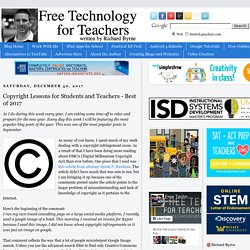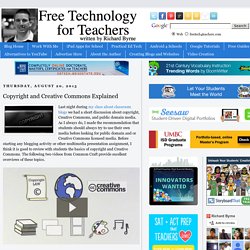

Copyright Lessons for Students and Teachers - Best of 2017. As I do during this week every year, I am taking some time off to relax and prepare for the new year.

Every day this week I will be featuring the most popular blog posts of the year. This was one of the most popular posts in September. As many of you know, I spent much of my week dealing with a copyright infringement issue. As a result of that I have been doing more reading about DMCA (Digital Millennium Copyright Act) than ever before. One piece that I read was this article from attorney Sarah F. Here's the beginning of the comment:I run my own travel consulting page on a large social media platform, I recently used a google image of a hotel. That comment reflects the way that a lot of people misinterpret Google Image search. On a similar note to the Google Images scenario, citing Facebook as the source of an image does not mean that you can use the image without permission.
Determining Website Credibility: A Rubric for Modern Digital Citizenship. Mitchell Kapor said it more eloquently than anyone: “Getting information off the Internet is like taking a drink from a fire hydrant.”

This rapid exponential growth of information across the Web makes it all the more difficult in determining website credibility. Our World Wide Web is a living, breathing, and constantly expanding phenomenon. As teachers of critical thinking skills, it’s important for us to provide guidelines for students to use when searching for content to use in their projects. Determining website credibility is a big part of these searches, and quick reference charts like the one here can be a big help. Whether for citations or research, our students need a strong grasp of Information Fluency for use in determining website credibility.
Whenever your students come across a resource they are interested in using, have them consider these 5 criteria which are included in the full rubric. About The Licenses. Our public copyright licenses incorporate a unique and innovative “three-layer” design. Each license begins as a traditional legal tool, in the kind of language and text formats that most lawyers know and love. We call this the Legal Code layer of each license. But since most creators, educators, and scientists are not in fact lawyers, we also make the licenses available in a format that normal people can read — the Commons Deed (also known as the “human readable” version of the license). The Commons Deed is a handy reference for licensors and licensees, summarizing and expressing some of the most important terms and conditions. Think of the Commons Deed as a user-friendly interface to the Legal Code beneath, although the Deed itself is not a license, and its contents are not part of the Legal Code itself.
Searching for open content is an important function enabled by our approach. Copyright and Creative Commons Explained. Last night during my class about classroom blogs we had a short discussion about copyright, Creative Commons, and public domain media.

As I always do, I made the recommendation that students should always try to use their own media before looking for public domain and or Creative Commons licensed media. Before starting any blogging activity or other multimedia presentation assignment, I think it is good to review with students the basics of copyright and Creative Commons. The following two videos from Common Craft provide excellent overviews of these topics.
For a more in-depth look at copyright for educators, watch Dr. Wesley Fryer's Slideshare on the topic. Common Craft videos can be viewed for free online but to download them or embed them you do have to be a subscriber to their service. Creative Commons. Choose a License. This work is licensed under the Creative Commons LICENSE_NAME License. To view a copy of this license, visit LICENSE_URL. We are currently testing a new version of the License Chooser. Please consider using the Chooser beta, and leave us feedback on how we can improve. Creative Commons is a non-profit organization. We need your support to continue providing these tools.
Lorem ipsum dolor sit amet... About earlier versions The most recent license version is 4.0, which can be used internationally. If your jurisdiction is not on this list, or if you want to use the latest version of the licenses instead of a ported license, you can return to the 4.0 license chooser. The New Creative Commons 4.0 Licenses.